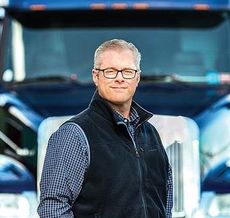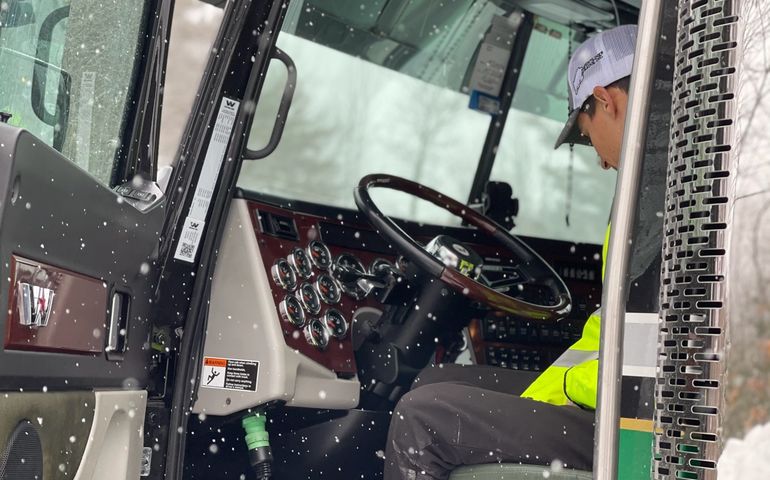
Trucking, TikTok and Gen Z: A traditional industry recruits its future workforce
 Courtesy / Maine Motor Transport Association
Kenny Chamberlain, owner/operator of Saint John Valley Transport LLC in Livermore, took part in a vlog-like episode that’s part of the video content developed to reach Gen Z. He’s seen here in a still from the video.
Courtesy / Maine Motor Transport Association
Kenny Chamberlain, owner/operator of Saint John Valley Transport LLC in Livermore, took part in a vlog-like episode that’s part of the video content developed to reach Gen Z. He’s seen here in a still from the video.
The shortage of drivers, technicians and other licensed professionals in Maine’s trucking industry is nothing new. But the impact goes further than you might think: In Maine, 84.4% of communities depend exclusively on trucks to move their goods.
A marketing campaign launched Tuesday is trying to fill the critical workforce gap by targeting Gen Z and others through social media platforms.
The Maine Motor Transport Association, an industry group based in Augusta, premiered “Go. Your way” to educate and excite Maine’s younger generations about the jobs, while trying to change misperceptions about the industry, according to a news release.
“A career in trucking is a great long-term option for individuals ready to get on the road to life — individuals who don’t necessarily want to follow the typical path of college loan debt followed by 40 years in an office cubicle,” Brian Parke, the association’s president and CEO, said in the release.
“As many industry professionals get set to retire over the next decade, we’re excited to welcome younger individuals into a career in trucking as soon as today.”
Parke said drivers can make an annual salary of between $49,000 and $58,000. Drivers with their own truck can earn $80,000 or more a year.
Click here to view the campaign.
Storytelling platforms
Maine’s trucking industry has at least a thousand open positions now, Parke told Mainebiz. The industry anticipates it will need to fill thousands of local and regional driver positions, technician jobs, freight handling, office support and other supporting roles in the next 10 years.

The campaign seeks to reach younger people by using video storytelling platforms like YouTube, TikTok and Instagram Reels and Stories.
Video content includes a year-long, vlog-like episodic video series on YouTube, that features a character who acts as an “ambassador” to go behind the scenes of the industry and learn what it’s like behind the wheel or under the hood. The content is leveraged in the campaign’s digital advertising effort on platforms like Instagram, Facebook and YouTube.
“The idea is to give folks an inside look into the industry to generate curiosity while showing them that trucking is a viable and exciting career,” said Parke. “Using a character who doesn’t know squat about the trucking industry allows him to lean into that lack of knowledge with some humor and interviews to show people what it’s really like and we have some amazing stories to share.”
The campaign also features a website with content designed to help individuals learn about various high-paying opportunities, answers questions, and provide assistance from industry insiders on how to get started.
“We look at it not like we’re selling careers as much as wanting to connect with people who don’t know about trucking,” Parke said.
No silver bullet
The campaign evolved through conversations over the last five years within the industry, he said.
“There hasn’t been any conversations with each of our 1,600 member companies that hasn’t revolved around the workforce shortage,” he said. “It’s a big issue, and we’ve been looking for different ways to solve the problem. There’s no silver bullet. This campaign is just one component. We’re trying to connect with people — young people in particular.”
Parke didn’t have a figure for the cost of the campaign, since it’s ongoing. It’s funded by the association and its membership, plus some non-dues sources of revenue.
The campaign was developed by Ethos, a branding, marketing and advertising firm in Westbrook.
“We didn’t know what we don’t know as far as how to approach the younger generations,” said Parke. “So they’re helping us focus on young people and connect with them on their social media platforms.”
The workforce shortage, exacerbated by the many truckers nearing retirement, has resulted in a chain reaction.
“We’re feeling the effects today of an aging workforce from yesterday,” he said. “And what’s happening is that trucking companies are having to look at their supply chains and make adjustments. The supply chain is still working. It could certainly work a lot more efficiently if there were a lot more professional drivers and technicians out there.”
Something for everyone
In addition to offering a competitive salary, people can get into the industry without a college degree.
“What we want to communicate through this campaign, is that Maine trucking is truly for young mavericks who want to control their own destiny and work in an industry that will always keep them employed,” Parke said. “There’s really something for everyone — from driving all over the country to working in operations.”
As of 2020, there were more than 5,300 trucking companies operating in Maine with total trucking industry wages exceeding $1.6 billion.
About one out of every 16 jobs in Maine is in the trucking industry. The industry says positions often go overlooked or unfilled despite continued demand, assurance of steady work, competitive pay and easily accessible training and education.
“The pandemic highlighted the essential nature of the trucking industry as stores scrambled early on to keep their shelves filled and keep medical supplies in stock,” Parke said. “An opportunity, unlike any other, has been presented for the trucking industry to show the value of its careers.”










0 Comments